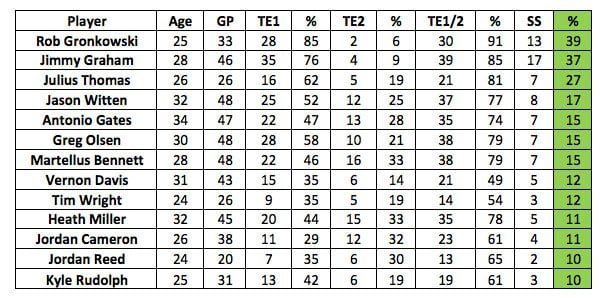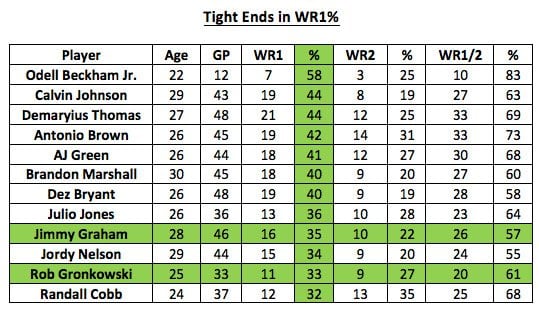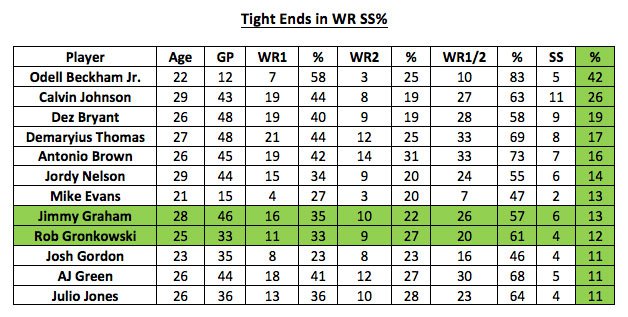Searching for Consistent Greatness: Tight Ends, Part Two

Yesterday, we began our thorough journey into tight end scoring. Before you read today’s post, make sure you read part one. Today, we’ll go through ‘superstar weeks,’ take a look at the rookie performances and do a comparison of tight ends and wide receivers. First, let’s review some things. Here are my general thoughts on the position:
- Tight ends (as a whole) score fewer points than other positions, so I value them accordingly (the fourth most important)
- Outside of Gronkowski and Graham, it is hard to predict who will excel from year-to-year
- My preferred strategy is to pair one or two ‘breakout potential’ second/third year players with a savvy veteran like Antonio Gates or Heath Miller
- I avoid rookie tight ends (or at least never rely on them in a starting lineup)
The Method
[am4show have=’g1;’ guest_error=’sub_message’ user_error=’sub_message’ ]
I categorize a top 12 weekly player as a ‘1’ and player who placed between 13 and 24 as a ‘2’. While placing in the 24 is fine, difference makers get in the top 12 often when they play. I began by working out how many points, on average, it takes to be a ‘1’ or a ‘2’ at tight end by going back through every fantasy gameweek from 2012-14.
- TE1: 10.8
- TE2: 6.2
Clearly, these numbers are extremely low in comparison to the positions we have covered so far. In fact, a score of 6.2 from a running back would barely scrape them into the top 50 in any given week and for a wide receiver it wouldn’t come close. A top 24 tight end score may make a slight difference, but unless your starter gets in that top 12, does it really matter if you have the TE13 or the TE24? The next stage of the research involved taking the tight ends in the ADP data and calculating how many times they placed in each of the categories over the last three years in games they played. I then filtered them by highest and lowest percentages in each category, and outlined them below.
Notes:
- Data was taken from FFToday.com (http://fftoday.com/stats/playerstats.php)
- PPR scoring
- Playoff games were not included
Key:
- GP – Number of games played
- TE1/2 – Number of games with 6.2+ points
- TE1 – Number of games with 10.8+ points
- TE2 – Number of games with between 6.2 and 10.8 points
- % – Percentage of games placing in each category
The numbers to focus on when looking at each list are highlighted (green = good, red = bad).

- As usual, rookie tight ends didn’t fare so well. Of course, dynasty isn’t a one-year deal, but in any contending team; you don’t want to be starting a first-year player.
- Only 26 tight ends have ever gone over 500 yards in their rookie year and only two rookie tight ends in the past 15 years have scored over five touchdowns (Gronkowski and teammate Aaron Hernandez in 2010).
- I am a Jace Amaro fan and while I expect Brandon Marshall to hog targets, his presence will only help the second year potential breakout candidate.
Superstar Weeks
This is one more way to separate the best of the best. Despite the low top 12 and top 24 numbers, the average top overall weekly tight end scorer amassed 27.8 fantasy points. I used the difference between this number and the top 12 score (10.8) to set the bar for a ‘superstar’ week at 19.3 points.

- The top two are still clearly ahead of everyone else
- Julius Thomas is seemingly in his own tier, with 10% separating him from the two above and the rest below. I am scared of Thomas given his move from Peyton Manning to Blake Bortles. It doesn’t sound pretty, and I don’t think it will look pretty
- Jason Witten may surprise some with his inclusion here, but he did have a huge 2013 with five superstar weeks. Last year, however, he only had one SS week and his lowest point total since 2006. Does he have a Gates-style rebound in him?
A Tight End-Wide Receiver Comparison
If you’ve ever heard the phrase “starting Rob Gronkowski is like starting an extra wide receiver”, you will probably want to know how true that is. I used the WR baselines from the last piece in the series and slotted in the top five tight ends in ADP data. The wide receiver baselines were 14.7 for a WR2, 20.2 for a WR1 and 29.1 for an SS. Here they are as a group, followed by their placing in the receiver lists:

- There is a huge drop off in percentages for everyone, but the gap between the top two and the rest of the field is now huge.
- With the higher baselines, Graham now takes a slight edge over Gronkowski in the higher-requirement categories.

- Sure enough, they slot right in with the best receivers in the game.
- Below them, Thomas placed 32nd (between Jeremy Maclin and Torrey Smith), Olsen 42nd and Kelce 46th.

- Once again, they really do provide wide receiver-type scoring, giving you as consistent top twelve receiver weeks as Green Bay studs Jordy Nelson and Randall Cobb.
- Thomas came in 28th, between Roddy White and Josh Gordon, while Olsen and Kelce were way down in 42nd and 55th respectively.

- The wide receiver superstar benchmark was a large number, but Graham and Gronkowski still match up with the competition.
- Thomas is down in 21st (with Victor Cruz and Alshon Jeffery), Olsen was right near the bottom of the list with one superstar week and Kelce has not yet hit the benchmark.
Conclusion
Well, this just turned into a Gronk and Graham love-fest. They are simply fantastic dynasty assets. What do we take from it? I’ve never owned the former Saint on any fantasy team, but 2015 might be the season I do. His price point has always scared me, something which was clear last year. Gronkowski was worth a pick coming off injury, but Graham’s expectations were too high. This year, however, I might be jumping on the ‘fade Gronk’ train simply because of his price. Sure, Graham’s situation has changed, but his ADP remains a whole round lower. These two have both enjoyed similar production and if I can get either on the cheap, I’ll do it.
As for the strategy past the top two; it is still ‘wait.’ If you miss out, you will only face them once or twice a year. You won’t be competing against many different teams made up of these two, so all you need from the position is a solid floor with a chance of weekly success and you can focus your energy elsewhere. Having two or three solid options allows you to stream and maximise your scoring without spending early draft capital.
[/am4show]
- 2022 Rookie Class: An Early Look at Kenny Pickett, QB Pittsburgh - January 31, 2022
- Dynasty Fantasy Football Rookie Update: Quez Watkins, WR PHI - July 15, 2020
- Dynasty Fantasy Football Rookie Update: John Hightower, WR PHI - July 7, 2020

































































